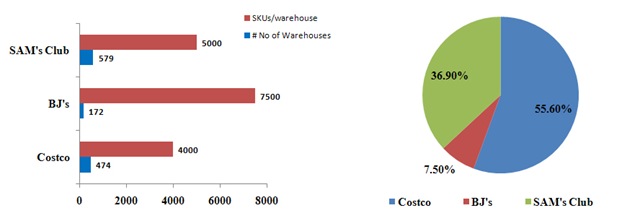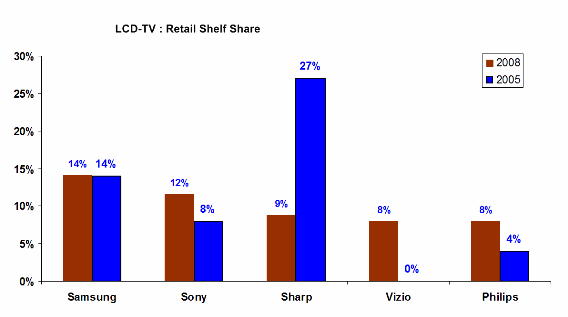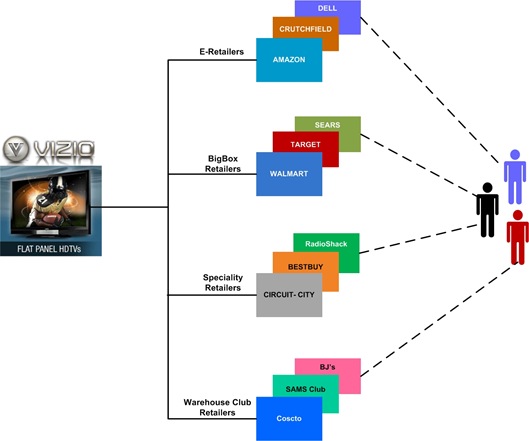When Digital-TV entered mainstream North American market the price point for a 40-in plasma and LCD-TV system averaged around $2000 – $2500 (2003/2004). With an average CRT TV selling well under $500 the market for HDTV was limited to early adopters and lead users with significant disposable incomes.
Given the dynamics in consumer behavior Vizio’s target market segment for its initial launch was limited to the 35+ age group, who are affluent, college educated with significant disposable income. LCD TV’s sold by Vizio weren’t particularly known for superior image quality or build quality, but rather for affordability and value for the money.
The target market segment for its initial launch was limited to the 35+ age group, who are affluent, college educated with significant disposable income. LCD TV’s sold by weren’t particularly known for superior image quality or build quality, but rather for affordability and value for the money.
How could a relatively new entrant such as Vizio establish a presence and reach its intended target customer base?
This analysis looks at why Vizio, the LCD-TV maker choose Costco as their retail channel of choice at entry. What were the strategic and competitive implications and the overall dynamics within the industry that a relatively new entrant such as Vizio faced when entering the highly competitive LCD TV market dominated by big global players. How did Vizio use their success from the warehouse club retail channel to finally gain entry into mass-market retailers?
Incumbents and Barriers to Market Entry
The market for consumer electronics and television systems has traditionally been dominated by well established players such as Sony, Panasonic, Philips, Toshiba, Samsung and LG among others. A comparative analysis on their strengths is captured in detail below.
|
Competitive Leverage |
Vizio |
Sony |
Samsung |
Sharp |
|
Access to Retail Channels |
Low |
Established Relationship |
Established Relationship |
Established Relationship |
|
Supplier Strength & Relationship |
Dependent on outside suppliers for LCD panel. May find itself at the mercy of component suppliers during high demand. Relies extensively on Contract Manufactures |
Manufactures Panels. Can leverage it position in market to squeeze component suppliers. Combination of Contract Manufactures and In-House Production. |
Manufactures Panels Can leverage it position in market to squeeze component suppliers. Combination of Contract Manufactures and In-House Production. |
Manufacturers Panels Can leverage it position in market to squeeze component suppliers. Combination of Contract Manufactures and In-House Production |
|
Access to Technology ( Software, Hardware, & Manufacturers ) |
Follow industry Leaders. |
In a position to dictate and control technology development and licensing. |
Can dictate and control technology development and licensing. |
Follow Industry Leaders |
|
Economies of Scale |
Limited in its ability to realize economies of scale. |
Economies of scale dependent on LCD units/ panels shipped because of HIGH CAPEX expenditures associated with FABS. |
Economies of scale dependent on LCD units/ panels shipped because of HIGH CAPEX expenditures associated with FABS |
Economies of scale dependent on LCD units/ panels shipped because of HIGH CAPEX expenditures associated with FABS |
|
Economies of Scope |
Relatively unknown brand with limited product offering. |
Brand name can be leveraged to realize economies of scope in marketing and product adoption. |
Brand name can be leveraged to realize economies of scope in marketing and product adoption. |
Brand name can be leveraged to realize economies of scope in marketing and product adoption. |
|
Pricing |
Has to undercut competitors to gain market share. |
Well known brand can command a Very HIGH premium |
Well known brand can command a HIGH premium |
Well known brand can command a premium |
Being a new and unknown entrant in a highly competitive market was one of the biggest challenges for VIZIO. To get an edge in the market VIZIO would need to differentiate based on price. In order to gain access to the customers using well established retail channels Vizio would have to strike retailer partnerships and provide better incentives than incumbent’s margins, sales commission and marketing promotions.
Being a new and unknown entrant in a highly competitive market was one of the biggest challenges for VIZIO. To get an edge in the market VIZIO would need to differentiate based on price. In order to gain access to the customers using well established retail channels would have to strike retailer partnerships and provide better incentives than incumbent’s margins, sales commission and marketing promotions.
The ideal customer segment that VIZIO went after was “Imitators” a self-informed segment with awareness about LCD-TV product and the technology. By going after “Imitators”, VIZIO won’t have to incur the costs of promoting the product to the innovator segment and ride on the marketing awareness generated by established incumbents.
North American Retail Channels and Power
The retail channel in North America is dominated by four major categories of retailers each with significant clout, market reach and market share:
- Big-Box Retailers : Wal-Mart, Target, Sears and the likes
- Specialty Electronics Retailers: Best Buy, Circuit-City, RadioShack and the likes
- Warehouse Club Retailers: Costco, Sam’s Club, BJ’s and others
- E-Retailers: Amazon, Crutchfield and Dell among others
Online retailers were not really an option for Vizio since the average consumer spent less than $300 on a consumer electronics purchase.
Retail Channel Costs and Margins
The various retail channels pose different challenges, margins and capability for Vizio in reaching its prospective end customer. Table below summarizes the key challenges with various retail channels.
|
Channel Characteristics |
Warehouse Club Retailers |
Traditional Retailers |
Specialty Electronic Retailers |
|
Marketing & Promotion Costs for Manufacturer |
Lowest |
High |
Highest |
|
Sales Commission |
None |
Low – Medium |
Medium – High |
|
Revenue / Profits Streams |
Mark Ups |
Markups, Volume Discount, Double Marginalization, Sales Promotions |
Markups, Volume Discount, Double Marginalization, Sales Promotions |
|
Influencing Buyer Purchase Decision |
Neutral |
Manufacturer Incentives and Commissions |
Manufacturer Incentives and Commissions |
|
Profit Margins |
10 – 15% |
20 – 30% |
25 – 40% |
|
Distribution & Logistics |
Managed by Retailer or 3rd Party Distributor |
3rd Party Distributor |
3rd Party Distributor |
Table 1: USA Retail Channel Characteristics and Costs
Warehouse VS. Retailer Margins
Keeping prices low was one of the key differentiating and positioning factors for VIZIO. Catering to high-end retailers meant that there could be additional marginal costs added by the retailer, which would hike up the price. The warehouse clubs do not double marginalize the products they sell since 70% of the revenues come from membership fees. By selling products only at warehouse club retailers, Vizio would avoid double marginalization and ensure a lower retail price for the consumer.
Warehouse Club Retailers and Market Reach
Some of the major players in the Warehouse Club Retailer space were BJ’s warehouse, Sam’s Club and Costco. The average stock keeping unit for each of these warehouses and the number of stores nationwide is shown below. Given the reach of this warehouse retail network to the consumer public, and its low margin cost model, VIZIO used these outlets as the channel for its products.

The three major warehouse club retailers are located throughout the USA, and offer full geographical coverage across the country. Therefore, their reach to the broad consumer base is not diminished. The break-up of VIZIO’s average sales percentage at each of these warehouse stores is shown in the chart above. As we can see, a large percentage of the sales will occur at Costco.
Analyzing Competition at Traditional Retail Channels using Game Theory
An intuition for incumbent reaction across traditional and specialty electronic retail channels can be built using the Game Theory. Based on anticipated response the incumbents will fight aggressively against Vizio’s entry. A protracted pricing war would seriously undermine Vizio given its limited financial resources to fight incumbent promotions, volumes discounts and sales commissions.
|
Unit Sales (Traditional Retailers) (Payoff is # Units Sold) |
Sony / Samsung / Philips / LG |
||
|
Fight |
Accommodate |
||
|
Vizio |
Fight |
30%, 70% (M+) |
40%, 60% (M) |
|
Accommodate |
20%, 80% (M) |
25%, 75% (M) |
|
If both incumbents and Vizio “Fight” there will be price erosion leading to an increased market size M+ (# units sold). All participants will benefit with established players such as Sony, Samsung and Philips gaining more than Vizio on account of their brand image and prevalence in the consumer electronics market.
If the incumbents and Vizio both accommodate, then there is no price erosion and market is expected to be M (# units sold).The market (M) will probably be split among all players and whoever accommodates is to expected loose share of market share to the other.
Analyzing Competition at Warehouse Club Retailers using Game Theory
An intuition for incumbent reaction across warehouse club retail channels can be analyzed using the Game Theory. Based on the anticipated response, the incumbents will ‘Accommodate’ & Vizio will ‘Fight’
One reason for this behavior is that the Federal Robinson-Patman Act that prohibits manufacturers and suppliers from providing price discounts and other forms of preferential treatment to some buyers and not to others. Existing contracts with traditional retailers will prohibit incumbents from matching Vizio’s low prices and margins offered to warehouse club retailers such as Costco.
|
Unit Sales (Warehouse Club Retailers)(Payoff is # Units Sold) |
Sony / Samsung / Philips / LG |
||
|
Fight |
Accommodate |
||
|
Vizio |
Fight |
30%, 70% (M+) |
40%, 60% (M) |
|
Accommodate |
20%, 80% (M) |
25%, 75% (M) |
|
Vizio – Costco Retail Partnership: A Win-Win
Vizio’s strategy to enter the retail channel with Costco to launch its range of LCD-TV’s was the right choice given the enormous power that USA retailers enjoy. The low-price strategy and lack of brand name were factors that played in favor of Costco.
At Costco, Vizio relied extensively on prospective buyers to pick its LCD-TV’s without any assistance from retail floor personnel in influencing and steering the customers during the sales process. The strategy made sense given Vizio low brand awareness. At traditional retailers Vizio would stand no chance competing against big brand names with marketing muscle and promotions aimed at influencing consumer buying process.
A typical USA Warehouse Club Shoppers shares the following traits:
- 35+ yrs,
- Affluent, with disposable income
Costco also requires that a manufacturer sell directly to them. This works in favor of Vizio and eliminates costs and markups associated with middle distributors.
Costco’s no frills based selling with minimal marketing and advertisement expenditures is synergistic with Vizio’s low cost approach to selling. Vizio as a new entrant does not have the advertisement and marketing budgets to take on established stalwarts such as Sony, Samsung, Sharp and others.
Given Vizio’s limited financial resources and low brand awareness, Costco was the ideal choice to enter the highly competitive LCD TV market for the following reasons:
- Costco’s profits margins and hence markup on products sold at its retail locations average between 10-15% compared to other retail channels. Allows Vizio to sell products at a lower cost its key differentiator against major brand names.
- Eliminates additional cost associated with maintaining a 3rd party distributor as Costco manages all its inventory and logistics in-house. Avoids channel conflicts associated with double marginalization as Costco negotiates a standard markup irrespective of the number of units sold or incentives offered.
- Vizio does not need to spend marketing dollars on sales commission or to run major promotions and advertisement campaigns. Costco runs a lean-mean marketing campaign with limited promotions advertised only to members.
Vizio success can be attributed to its unique channel strategy. Its warehouse club channel focus and lack of channel conflicts enabled the company to achieve disruptive price points-helping to fuel the rapid rise of the warehouse club channel in the US TV market and causing its shipments to surge.
Expanding Retail presence
Finally, VIZIO management knew that they did need to make a concerted effort to move outside the warehouse club channel and did so successfully at Circuit City, Sears and Wal-Mart. The early success with Costco and Sam’s club that enabled Vizio to reach #3 ranking by 2006 allowed it to negotiate better terms and gains additional retail presence.
Vizio was able to maintain the Club channel price points in most cases and benefited nicely from Circuit City and Wal-Mart ramping in Q2 2007, which resulted in significant growth and the #1 ranking in the North American flat panel TV market. 
Acknowledgments:
This analysis would not have been completed without the helpful and critical inputs provided by Archana Arunkumar, Anoop Ramgiri and Venkata Duvvuri. The informal discussions with Costco retail store employees have also contributed immensely in understanding the business of warehouse club retailers.
References:
- DisplaySearch LCD-TV Market Research data
- Samsung LCD-TV projections 2005 – 2011
- US Census Bureau Annual Benchmark Report for Retail Trade, 2006
- NPD Group
- ABI Shopper Poll, Nov 2005
- Costco : Telsey Advisory Group Report
- Vizio Company Press Releases.

